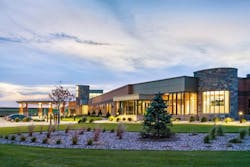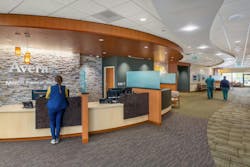The unique design needs of Critical Access Hospitals
If you live in an urban area, you may take for granted that you can call emergency services and have someone on the scene within minutes or hop in the car to reach a hospital before a bad situation gets worse. That’s not the case for the tens of millions of Americans who live more than an hour away from the nearest trauma care center.
Fortunately, Critical Access Hospitals are there to step into the gap, to keep care accessible and local, so long-distance transportation isn’t a barrier to care. This is a designation given to eligible hospitals that provide essential care to rural and often underserved populations. A Critical Access Hospital must meet a long list of criteria to be granted the status and receive federal funding. There are different types of Critical Access Hospitals, and each has their own unique needs based on their capabilities, requirements, locations, and the communities they serve.
As you can imagine, architecture and design are essential elements for making sure that Critical Access Hospitals meet the criteria to receive funding, as well as meet the needs of their staff and patients. It takes a lot of ingenuity and partnership to address the unique challenges and opportunities faced by Critical Access Hospitals, and BWBR has a long history of doing just that.
To learn more, we sat down with two BWBR healthcare principals: Brad Krump, AIA from the Saint Paul office, and Scott Kirchner, AIA, leader of the Omaha office. Both have deep industry experience and passion for supporting the important role these facilities play in their communities.
Customization is Critical
When it comes to these hospitals, tailored design is paramount. Brad notes that there’s a strong desire among many Critical Access Hospital leaders to remain independent, as opposed to being part of a larger system, allowing them to make decisions about their future and cater their services to the specific needs of their communities. At the same time, rising construction costs and economic concerns create a significant barrier to independence. Brad and Scott say that it’s their job to work closely with the staff to understand their precise needs and create efficiencies wherever possible.
It’s a high-stakes situation, and not only for the current and future patients. “Critical Access Hospitals tend to be the biggest employer in their communities,” says Scott. That means that maintaining independence and “keeping those employment decisions at the local level is huge.” Brad, Scott, and their colleagues work hard to develop a deep, localized understanding so they can balance budgets and needs while making sure that criteria are met so the facility can receive funding. It’s a big challenge, but they’re up for it.
Finding the Balance for Critical Access Hospitals
One of the criteria for Critical Access Hospital designation is that it must be located 35 miles or further from the nearest comparable facility. What happens in communities that are just shy of that distance? In 2021, legislation passed to support conversion to Rural Emergency Hospitals. This conversion presents a whole different set of challenges—including losing inpatient beds in favor of critical care beds. It means completely transforming the way the facility provides care. That’s more than a renovation; it’s a total reimagining—and can touch on lots of sensitivities within the community.
Brad and Scott note that these rural facilities must be set up not only for physical health care services but, whenever possible, also for mental and behavioral health services, which are often severely lacking in rural communities. Of course, in all types of healthcare, preserving the dignity and humanity of the patients and protecting staff and patient safety are top priorities. And yet, in order to achieve those priorities, treating physical and mental health call for totally different approaches to care and facility design. From whether safe rooms are needed, to how long patients are expected to stay, to external access points, there are many factors at play that need to be carefully considered.
No Such Thing as One-Size Fits All
By now it’s likely becoming clear that, when it comes to designing Critical Access Hospitals and other rural facilities, there is no one “right” way to proceed. The whole point is to do the hard work of stakeholder engagement and community research to create a tailored solution—one that hits every requirement for funding and also provides tremendous value to the local area.
Brad notes that he grew up in a small, rural community and this type of work is near and dear to his heart. He says it’s about providing flexible, adaptable spaces that are right-sized and built to support the organization’s operations. “My goal is to be a trusted strategic advisor based on the team’s experience in critical access health.” Scott adds, “I love working in these facilities, because the people there are doing it for the right reasons. They’re giving back to their communities, and we’re there to help them up their game.”

